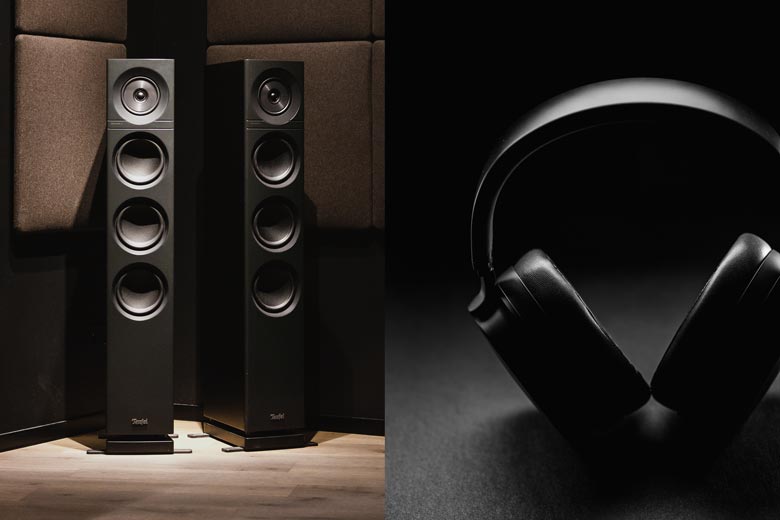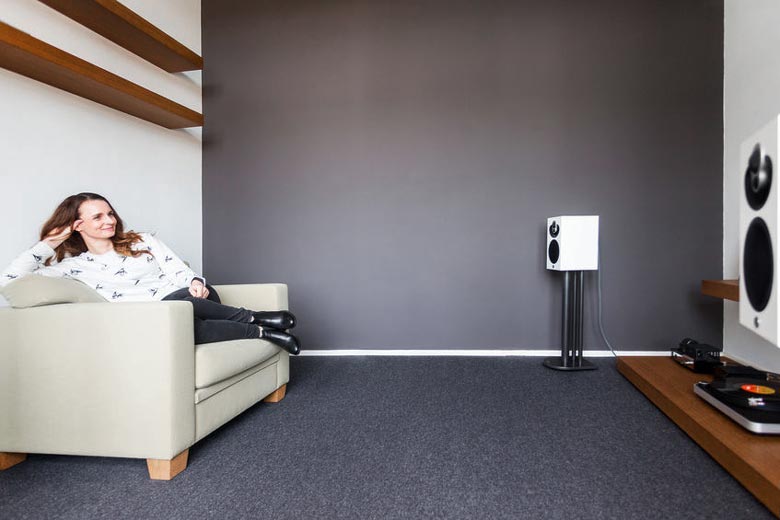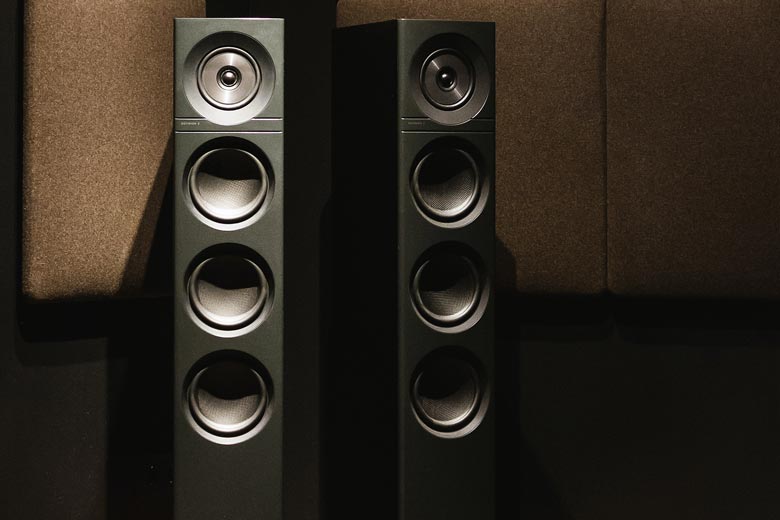Whether you get speakers or headphones, you’ll be able to get incredible sound. Still, each one has its own strengths and weaknesses. Depending on what you’re planning to do with your music, one might be better suited to your needs than the other.
Speakers can create a rich soundstage and stereo imaging, but the room’s acoustics can create interference. Headphones can be more accurate and give you better sound quality for the same amount of money but aren’t as good at making you feel the sound is coming from “outside” your head.
A true audiophile knows how to enjoy both speakers and headphones, but not everyone can spend big bucks on top-tier models from both groups. So, when you have to choose, what are the differences that truly matter?

What Is the Difference Between Speakers and Headphones?
Speakers and headphones are different in how they sound. Headphones can be slightly more accurate because they mostly don’t deal with acoustics. However, speakers can create a better soundstage and stereo imaging.
Before comparing them in every detail, remember that sound quality is partly subjective. If you’re torn, choose the one that will give you the best listening experience.
Pros and Cons of Headphones
Pros
- They can be more accurate.
- They give you a better bang for your buck.
- You can use them anywhere as long as they’re closed-back.
Cons
- They have a harder time creating a good soundstage (they won’t sound as “spacious”).
- Lower frequencies can’t be “felt” as much.
Pros and Cons of Speakers
Pros
- They can fill the entire room.
- They create an excellent soundstage and stereo imaging.
- Woofers let you “feel” the bass.
Cons
- You’ll have to make a bigger investment for the same sound quality.
- Acoustics can meddle with sound accuracy.
- You can’t take them with you on the go.
5 Differences Between Speakers and Headphones
1. Accuracy
Accuracy is one of the first things that come to mind when evaluating a sound system. Overall, headphones have a much easier time reproducing an accurate sound. But at the same time, many listeners feel speakers sound more “real.”
So, what does accuracy really mean in the context of sound?
In short, accurate sound is able to reproduce a recording without any distortions in frequency or timing.
For headphones and speakers, accuracy means matching the sound data in your computer, phone, or sound system as closely as possible.
Since this is the last step on the audio chain, accuracy doesn’t determine by itself how “real” music can sound. If the recording was poorly made or you’re listening to a low-quality audio file, the most accurate speaker or headphones on the market won’t be able to fix that.
If we get mixing out of the way, there’s a factor that has a huge effect on the accuracy of the sound that gets to our ears: acoustics.
It’s very rare for a room to have perfect acoustics. A room with great acoustics usually needs significant investment and a lot of care put into its planning.
The soundwaves that come out of your speakers will collide with walls and objects in your room. This affects the accuracy of the sound.
It’s not just the shape of your room, but also where you place your speakers. The distance between them, their orientation, how far away they are from the wall… All these things can deviate speakers from an “ideally” accurate sound.

Since speakers are placed and oriented in a 3D space, the direction you’re listening from also varies greatly. If you move away from the center, you might experience a less accurate sound, with some frequencies taking over others.
Headphones, on the other hand, have a much easier time dealing with acoustics. It’s not like the problem isn’t there. For instance, ear canals differ from person to person, and drivers that aren’t perfectly oriented can cause small echoes and distortions.
However, the fact is that headphones have much fewer variables to deal with. Instead of spreading the sound through a room, they send it directly into your ears.
Headphones have more control over what they reproduce. A great pair of cans usually lets you catch details that are sometimes lost on speakers, like the plucking of a string or the hammering of a key.
Since they’re in your head at all times, the problem of being off-center is out of the equation.
Headphones can have some issues dealing with the resonance distortion or how sound bounces inside their closed off-space. However, most quality headphones are designed to minimize those issues.
Does this mean that headphones sound more real than speakers? Well, not necessarily.
Other factors come into play, which we will talk about next. But if accuracy is the only thing you’re measuring, it will be easier to get it with headphones than with speakers.
2. Stereo Imaging and Soundstage
Stereo imaging is the process of manipulating sound to create a perception of locality. It’s a crucial part of making a sound system sound great, both in speakers and headphones.
Stereo imaging also creates a seamless soundstage that, if done well, seems to eliminate the pair of speakers from the room —or your head.
Soundstage is the apparent three-dimensional space where different sounds are distributed. Some instruments can sound farther away than others or from different directions. It’s what makes instruments move from side to side or feel closer to you than others.
Good stereo imaging should have an ample range of width and depth. Width determines where a sound is “placed” inside the 180° range of the stereo image. Depth refers to how far or near a sound appears to be.
The fundamentals of stereo imaging don’t change from speakers to headphones. After all, both come in pairs, one piece for each side. However, headphones have to go through more hurdles to achieve great stereo imaging and soundstage.
Speakers have at least part of the job done from the start since they already are some distance away from you. The soundwaves coming from each speaker have a chance to mix and create a soundstage before getting to your ears.
Meanwhile, each headphone driver is oriented exclusively at one ear.
Good headphones still seem to “disappear” as speakers do, but it often feels like the music is coming from inside your head rather than from an outside source.
It’s not that they aren’t precise. They can reproduce stereo imaging and a sense of ambiance with as much accuracy, or even more, than speakers. The issue likely lies in the fact that sounds can’t mix before getting to your ears.
Closed-back headphones have limited options when facing this problem. Sound waves may bounce inside them, creating unwanted reverberations. This makes it harder to achieve a deep soundstage.
Related article: Do IEMs Have Any Soundstage? Audio Facts Explained
Headphone manufacturers have found ways to counter this problem, like better materials and smart design.
Open-back headphones perform much better when it comes to imaging and soundstage. They manage to give the illusion of having the sound come from outside the headphones, and some cans have their drivers angled at 30° degrees to imitate the direction of a speaker’s sound.
Still, for many audiophiles, even headphones with superb soundstage can’t replicate the depth and width of good speakers.
3. Drivers
Drivers are the backbone of how these devices work, and it’s what ultimately creates the sound you hear.
Drivers are devices that produce vibrations in the air to create sound. They turn electrical energy into acoustic energy.
In general, headphones carry one driver on each side. These drivers are in charge of reproducing the entire range of frequencies the device is designed for, and they do that more than well enough.
In a way, having a single driver represents an advantage. Since headphones can control all the frequencies in a single place, it becomes easier to deliver an accurate sound.
On the other hand, speakers usually carry more than one driver. The more money speakers cost, the more likely they are to have at least one driver for treble and another for bass, or even one for middle frequencies too.

The reason speakers use more than one driver has to do with their size.
Larger drivers allow for louder sound, which speakers need. But they also come with more directionality. This isn’t a problem for lower frequencies, but for higher ones, it means that the range of the sound becomes much more narrow.
To solve this issue, speakers contain drivers designed for specific frequencies. A network called crossover takes care of dividing up the frequencies and sending them to their respective drivers.
Treble drivers are called tweeters, and bass drivers are called woofers.
Having several drivers increases the chance of synchronization and crossover issues. But it also comes with some perks, like a better soundstage and, most noticeable, a bass that you can actually feel.
You might have seen sets of speakers that, together with their left and right pieces, also have a third piece with a large conical hole on the back or the front. This piece is called a subwoofer, and it deals exclusively with low frequencies.
Inside subwoofers, you can find large “woofers.” They are specifically designed to produce powerful lower frequencies without distortion and take that strain off the other speakers.
They achieve this, partly, thanks to that hole you see on their back. These ports or vents are called bass reflex enclosures. Drivers, even subwoofers, can only go so far when reproducing low frequencies, and bass reflex enclosures allow them to go a little lower.
Read more: Ever Wonder Why Speakers Have Holes? Here’s Why!
These ports are tuned to produce a sound just below what the driver is capable of, and for that, they use the sound pressure coming from the driver. You can often see them in normal speakers, too.
The result is that you can physically feel the vibration of these lower frequencies. The effect is unmistakable, just like what you feel inside a movie theater or at a concert.
Naturally, this is something that headphones simply can’t achieve. It’s not that they can’t reproduce bass: They can do it very precisely. But since they are smaller and often enclosed, there’s very little air to move around.
It mostly doesn’t matter since the closeness with your eardrums lets their drivers be extremely efficient. However, they just can’t move enough air to make you feel the bass like a set of speakers could.
4. Price
Speakers are bigger and have more pieces than headphones. They come with several drivers for different frequencies, an amplifier, more connections, a box to fit them in, and often a separate subwoofer.
They can also produce sounds loud enough to fill a large space, which is obviously something that doesn’t apply to headphones. Louder sounds require higher amounts of energy, which adds another layer of parts and engineering.

For these and other reasons, speakers are more expensive to make than headphones. If you compare a speaker and a headphone, both capable of achieving the same sound quality, the speaker will surely be much more expensive.
Strictly speaking, for the same amount of money, you’ll get better sound quality from a pair of headphones than from speakers.
Naturally, there are plenty of reasons why you might prefer speakers. For one, headphones can’t replace speakers in their function of filling a place with music.
There are many other functions that only speakers provide. They can be decorative furniture, they can liven up a party, and their sound is more customizable due to all the hardware involved (although the last thing only matters if you enjoy tinkering with the technical parts of audio).
Besides, you might simply prefer the way music sounds coming from speakers. Many audiophiles certainly do.
All this is to say that a pair of headphones doesn’t necessarily have better value than an equally prized set of speakers. It depends on what you want to get out of your sound device.
However, if you’re on a budget and the only thing you care about is sound quality, then it will be more worth it to invest in headphones.
5. Convenience
This one is more or less self-explanatory. Speakers can fill a room with sound, but often that’s something you can’t give yourself the luxury of doing.
If you can’t make too much noise where you live, you might not be able to fully enjoy your speakers. And if you want to listen to your music at a coffee shop or a library, taking your speakers with you isn’t exactly an option.

Headphones can give you the same sound fidelity as a speaker can give you (or even more) with the benefit of being portable and private.
If you’ll be traveling or want to listen to music at different places, then headphones are the only choice.
It’s worth noting that, although headphones can be convenient, they aren’t always. Many headphone models, especially open-back ones, are designed to never leave your desktop.
Often, these more expensive cans will require an external DAC/amplifier to run properly.
Also, since they are open-back, they will leak out their sound and let all the outside noise in, making them unsuitable to use anywhere that isn’t quiet.
Still, clunky high-end open-back headphones occupy much less space than a decent pair of speakers. And we already talked about reasons it’s worth it to buy headphones for their sound only.
Another way in which headphones are more convenient is that they require little or no setup. Meanwhile, a good pair of speakers need to be properly distanced and placed to function at their best. There is also a higher chance of compatibility issues with cables, currents, and so on.
But, of course, convenience might mean a different thing to you. Perhaps the most convenient thing for you is to be able to share your music. Or maybe you want to listen to music around your house freely without wearing something on your head.
Whatever you’re looking for in “convenience,” it won’t be too hard to find an answer. Just know you can get an amazing sound either way.
The Verdict
Now that we’ve gone over the most important differences between headphones and speakers, which one is better?
As you might have guessed, it depends on what you need.
If you’re looking for the most accurate sound possible, go for headphones. You’ll need excellent listening conditions and a lot of effort to achieve the same accuracy with speakers.
If you really care about how music feels around you, then speakers will do a better job.
Other than that, it’s a matter of price and convenience. If you’re on a budget, you’ll obtain better sound from headphones than equivalently priced speakers.
